Camels example¶
Use test cosmological simulation data (from the CAMELS simulations) to generate spectra and calculate photometry.
[1]:
import matplotlib.pyplot as plt
import numpy as np
from synthesizer.filters import UVJ
from synthesizer.grid import Grid
from synthesizer.load_data.load_camels import load_CAMELS_IllustrisTNG
from synthesizer.sed import Sed
from unyt import Myr
[2]:
grid_dir = "../../../tests/test_grid"
grid_name = "test_grid"
grid = Grid(grid_name, grid_dir=grid_dir)
We then need to load our galaxy data. There are custom data loading script for different simulation codes in synthesizer.load_data. For CAMELS-IllutrisTNG there is the load_CAMELS_IllutrisTNG method
If your simulation does not have its own front end, please use the templates in synthesizer/load_data.py to create your own.
[3]:
gals = load_CAMELS_IllustrisTNG(
"../../../tests/data/",
snap_name="camels_snap.hdf5",
fof_name="camels_subhalo.hdf5",
)
len(gals)
/home/runner/work/synthesizer/synthesizer/src/synthesizer/particle/galaxy.py:110: RuntimeWarning: In `load_stars`: one of either `initial_masses`, `ages` or `metallicities` is not provided, setting `stars` object to `None`
self.load_stars(stars=stars)
/home/runner/work/synthesizer/synthesizer/src/synthesizer/particle/galaxy.py:111: RuntimeWarning: In `load_gas`: one of either `masses` or `metallicities` is not provided, setting `gas` object to `None`
self.load_gas(gas=gas)
/opt/hostedtoolcache/Python/3.10.14/x64/lib/python3.10/site-packages/unyt/array.py:1949: RuntimeWarning: invalid value encountered in divide
out_arr = func(
[3]:
10
this creates gals, which is a list containing a synthesizer.Galaxy object for each structure in the subfind file. These Galaxy objects contain lots of useful methods for acting on galaxies, in addition to the component parts of a galaxy. These components include Stars, Gas, and BlackHoles. To generate the intrinsic spectrum of the stellar component we can do the following.
[4]:
g = gals[1]
spec = g.stars.get_spectra_incident(grid)
Here we grab a single galaxy, and call stars.get_spectra_incident, providing our grid object as the first argument. This returns the spectra as an Sed object (see the SED docs).
To access the luminosity and wavelength for _spec we can now do
[5]:
spec.lam[:10], spec.lnu[:10]
[5]:
(unyt_array([0.00012966, 0.0001336 , 0.00013766, 0.00014184, 0.00014615,
0.00015059, 0.00015516, 0.00015988, 0.00016474, 0.00016974], 'Å'),
unyt_array([0., 0., 0., 0., 0., 0., 0., 0., 0., 0.], 'erg/(Hz*s)'))
Notice that these are unyt arrays with associated units. To plot the spectra manually we can do the following.
[6]:
plt.loglog(spec.lam, spec.lnu)
plt.xlabel("$\\lambda \\,/\\, \\AA$")
plt.ylabel("$L_{\\nu} \\,/\\, \\mathrm{erg \\; s^{-1} \\; Hz^{-1}}$")
[6]:
Text(0, 0.5, '$L_{\\nu} \\,/\\, \\mathrm{erg \\; s^{-1} \\; Hz^{-1}}$')
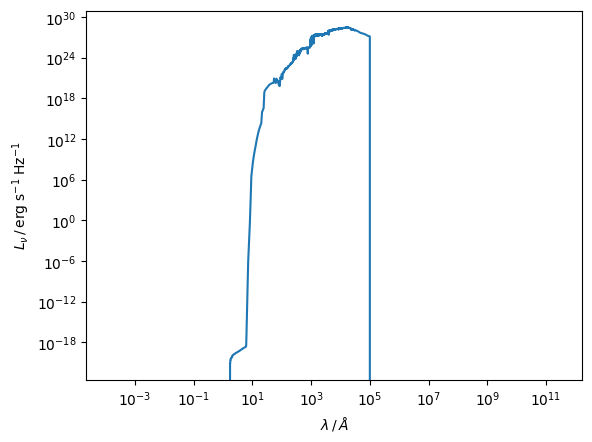
However, we can also use the stars.plot_spectra method in the stars object (and, indeed, all other components) to plot all of the spectra associated with a galaxy at once.
[7]:
g.stars.plot_spectra()
plt.show()
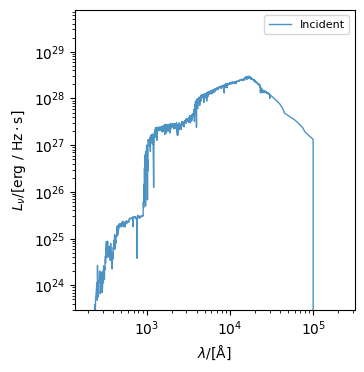
Why might you want to create an Sed object? This class contains a lot of useful functionality for working with SED’s. For example, we can calculate the broadband luminosities.
First, get rest frame ‘flux’ from the Sed.
[8]:
spec.get_fnu0()
[8]:
unyt_array([0., 0., 0., ..., 0., 0., 0.], 'nJy')
To get broadband luminosity we first need to define a filter collection object (UVJ default).
[9]:
fc = UVJ(new_lam=grid.lam)
And then we can apply it using the Sed helper function.
[10]:
_UVJ = spec.get_photo_fluxes(fc)
print(_UVJ)
--------------------------------------------------
| PHOTOMETRY (FLUX) |
|--------------------|---------------------------|
| U (λ = 3.64e+03 Å) | 4.16e-13 erg/(Hz*cm**2*s) |
|--------------------|---------------------------|
| V (λ = 5.51e+03 Å) | 1.07e-12 erg/(Hz*cm**2*s) |
|--------------------|---------------------------|
| J (λ = 1.22e+04 Å) | 1.94e-12 erg/(Hz*cm**2*s) |
--------------------------------------------------
Young and old stellar populations¶
We restrict the age of star particles used for calculating the spectra. The age is specified by the young and old parameters; these default to None, but if set to a value of age (in units of Myrs) they will filter the star particles above or below this value. If both young and old are set, the code will raise an error.
[11]:
young_spec = g.stars.get_spectra_incident(grid, young=100 * Myr)
old_spec = g.stars.get_spectra_incident(grid, old=100 * Myr)
plt.loglog(young_spec.lam, young_spec.lnu, label="young")
plt.loglog(old_spec.lam, old_spec.lnu, label="old")
plt.legend()
plt.xlabel("$\\lambda \\,/\\, \\AA$")
plt.ylabel("$L_{\\nu} \\,/\\, \\mathrm{erg \\; s^{-1} \\; Hz^{-1}}$")
[11]:
Text(0, 0.5, '$L_{\\nu} \\,/\\, \\mathrm{erg \\; s^{-1} \\; Hz^{-1}}$')
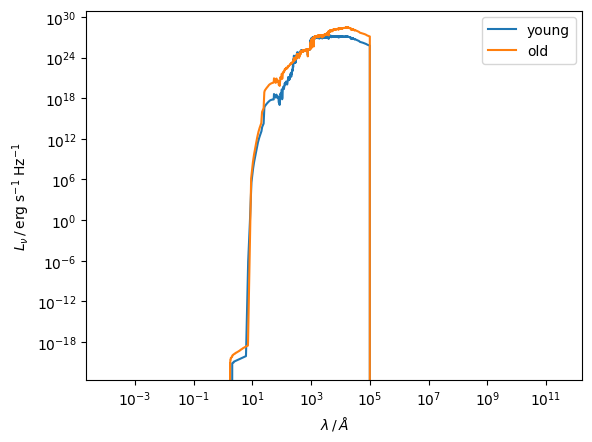
Replacing young star particles with Parametric Star Formation Histories¶
For simulations with low mass resolution, the sampling of the star formation history can be affected by Poisson scatter. This is particularly the case for young star particles; a single massive particle that happens to form close to the time of observation can significantly alter the integrated colour of the entire galaxy.
To mitigate this, we provide a method for smoothing the recent star formation history of a particle galaxy by replacing each young star particle with a parametric SFH. An example is provided here.
This functionality can be enabled by setting the argument parametric_young_stars on any get_spectra_* methods. This should be set to the age at which you wish to smooth the SFH. The default form of the SFH is constant, but this can also be modified by providing a parametric SFH object to the parametric_sfh argument.
[12]:
parametric_spec = g.stars.get_spectra_incident(
grid=grid, parametric_young_stars=500 * Myr
)
plt.loglog(young_spec.lam, young_spec.lnu + old_spec.lnu, label="Particle")
plt.loglog(
parametric_spec.lam, parametric_spec.lnu, label="Parametric + Particle"
)
plt.legend()
plt.xlabel("$\\lambda \\,/\\, \\AA$")
plt.ylabel("$L_{\\nu} \\,/\\, \\mathrm{erg \\; s^{-1} \\; Hz^{-1}}$")
[12]:
Text(0, 0.5, '$L_{\\nu} \\,/\\, \\mathrm{erg \\; s^{-1} \\; Hz^{-1}}$')
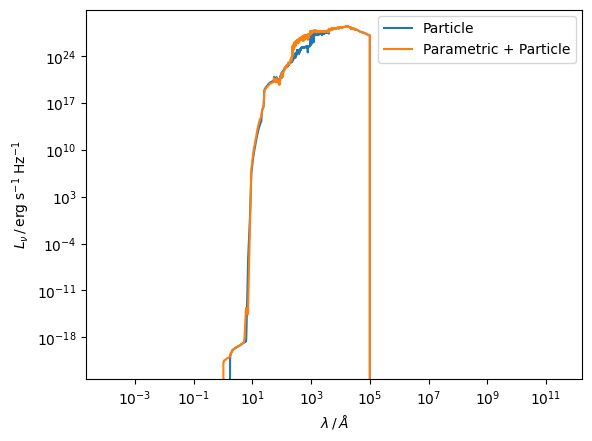
Nebular emission¶
If our grid file has been post-processed with CLOUDY we can produce the nebular emission for our camels galaxies. get_spectra_nebular produces the pure nebular emission
[13]:
spec = g.stars.get_spectra_nebular(grid)
fig, ax = g.stars.plot_spectra()
plt.show()

get_spectra_reprocessed calculates the gas reprocessed spectra, which we refer to as the reprocessed spectra, assuming some escape fraction fesc. The combination of the reprocessed and escaped spectra is the intrinsic spectra.
[14]:
spec = g.stars.get_spectra_reprocessed(grid, fesc=0.1)
fig, ax = g.stars.plot_spectra()
plt.show()
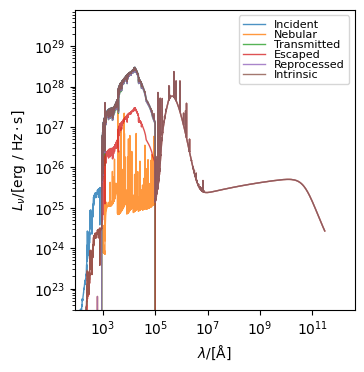
Dust attenuation¶
We can apply a range of different dust models to our intrinsic spectra. get_spectra_screen applies a simple dust screen to all stellar particles, assuming a V band optical depth \(\tau_V\)
[15]:
spec = g.stars.get_spectra_screen(grid, tau_v=0.33)
fig, ax = g.stars.plot_spectra(spectra_to_plot=["intrinsic", "emergent"])
plt.show()
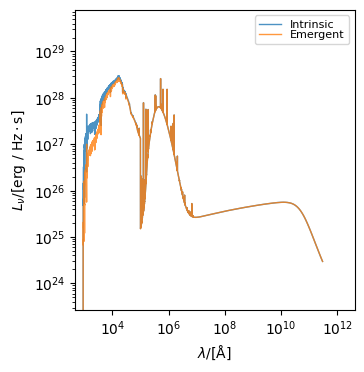
get_spectra_CharlotFall applies the Charlot & Fall+00 two component dust screen model, with V band attenuation for young and old populations defined by the \(\tau_V^{BC}\) and \(\tau_V^{ISM}\)
[16]:
spec = g.stars.get_spectra_CharlotFall(grid, tau_v_ISM=0.33, tau_v_BC=0.67)
fig, ax = g.stars.plot_spectra(spectra_to_plot=["intrinsic", "emergent"])
plt.show()
/home/runner/work/synthesizer/synthesizer/src/synthesizer/components/stellar.py:247: RuntimeWarning: Age mask has filtered out all particles
lnu = self.generate_lnu(
/home/runner/work/synthesizer/synthesizer/src/synthesizer/components/stellar.py:305: RuntimeWarning: Age mask has filtered out all particles
lnu = (1.0 - fesc) * self.generate_lnu(
/home/runner/work/synthesizer/synthesizer/src/synthesizer/components/stellar.py:362: RuntimeWarning: Age mask has filtered out all particles
lnu = self.generate_lnu(
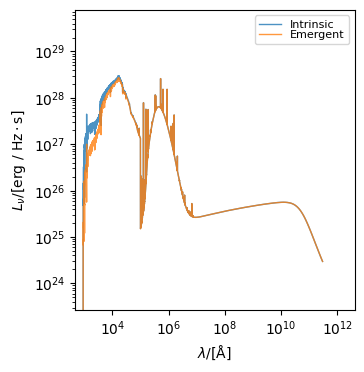
Multiple galaxies¶
If we want to create spectra for multiple galaxies we can use a list comprehension. Here we grab the luminosity lnu of each galaxy into a list, and combine into a single sed object afterwards using the grid wavelength.
[17]:
specs = np.vstack([g.stars.get_spectra_incident(grid).lnu for g in gals])
specs = Sed(lam=grid.lam, lnu=specs)
Importantly here, we don’t create an SED object for each galaxy spectra. We instead create the 2D array of spectra, and then create an Sed object for the whole collection.
[18]:
fig, ax = plt.subplots(1, 1)
ax.loglog(grid.lam, specs.lnu.T)
ax.set_ylim(
1e22,
)
ax.set_xlim(1e2, 2e4)
ax.set_xlabel("$\\lambda \\,/\\, \\AA$")
ax.set_ylabel("$L_{\\nu} \\,/\\, \\mathrm{erg \\; s^{-1} \\; Hz^{-1}}$")
[18]:
Text(0, 0.5, '$L_{\\nu} \\,/\\, \\mathrm{erg \\; s^{-1} \\; Hz^{-1}}$')
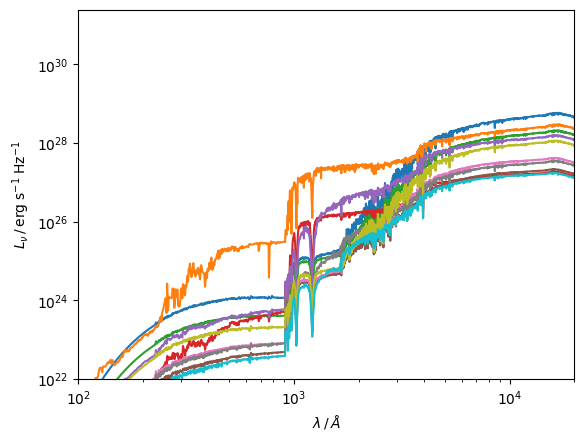
Calculate broadband luminosities¶
We can then use the Sed methods on the whole collection. This is much faster than calling the method for each spectra individually, since we can take advantage of vectorisation. For example, we can calculate UVJ colours of all the selected galaxies in just a couple of lines.
First get rest frame ‘flux’
[19]:
spec.get_fnu0()
[19]:
unyt_array([0.00000000e+00, 0.00000000e+00, 0.00000000e+00, ...,
2.50237145e+16, 2.49049046e+16, 2.47868296e+16], 'nJy')
Define a filter collection object (UVJ default) and calculate the photometry.
[20]:
fc = UVJ(new_lam=grid.lam)
_UVJ = spec.get_photo_fluxes(fc)
print(_UVJ)
_UVJ.plot_photometry(show=True)
--------------------------------------------------
| PHOTOMETRY (FLUX) |
|--------------------|---------------------------|
| U (λ = 3.64e+03 Å) | 2.58e-13 erg/(Hz*cm**2*s) |
|--------------------|---------------------------|
| V (λ = 5.51e+03 Å) | 7.73e-13 erg/(Hz*cm**2*s) |
|--------------------|---------------------------|
| J (λ = 1.22e+04 Å) | 1.67e-12 erg/(Hz*cm**2*s) |
--------------------------------------------------
[20]:
(<Figure size 350x500 with 2 Axes>,
<Axes: xlabel='$\\lambda_\\mathrm{obs}/[\\mathrm{\\AA}]$', ylabel='$F/[\\mathrm{\\rm{erg} \\ / \\ \\rm{Hz \\cdot \\rm{cm}^{2} \\cdot \\rm{s}}}]$'>)
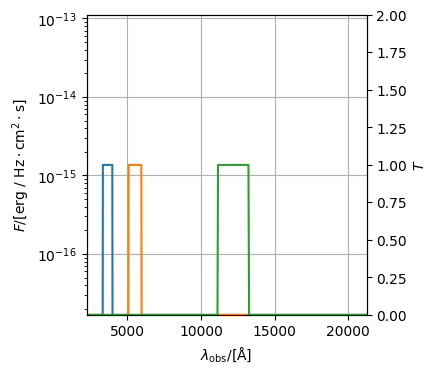
Do for multiple, plot UVJ diagram, coloured by \(M_{\star}\)
[21]:
mstar = np.log10(
np.array([np.sum(g.stars.initial_masses) for g in gals]) * 1e10
)
[22]:
specs.get_fnu0()
_UVJ = specs.get_photo_fluxes(fc)
UV = _UVJ["U"] / _UVJ["V"]
VJ = _UVJ["V"] / _UVJ["J"]
plt.scatter(VJ, UV, c=mstar, s=40)
plt.xlabel("VJ")
plt.ylabel("UV")
plt.colorbar(
label=r"$\mathrm{log_{10}} \, M_{\star} \,/\, \mathrm{M_{\odot}}$"
)
[22]:
<matplotlib.colorbar.Colorbar at 0x7f7f5fbe5ff0>

Collective operations¶
It is often useful to collectively do different operations on a Galaxy. Synthesizer enables this via some wrapper methods on a galaxy which will operate on it’s components to, for instance, get the observed spectra or photometry for all spectra nested in a Galaxy.
[23]:
from astropy.cosmology import Planck18 as cosmo
# Get observed spectra for all spectra
g.get_observed_spectra(cosmo=cosmo)
# Get UVJ photometry for all spectra
g.get_photo_luminosities(fc)
g.get_photo_fluxes(fc)
print(
"Stellar luminosities available:", list(g.stars.photo_luminosities.keys())
)
print("Stellar fluxes available:", list(g.stars.photo_fluxes.keys()))
Stellar luminosities available: ['incident', 'nebular', 'transmitted', 'escaped', 'reprocessed', 'intrinsic', 'emergent', 'young_incident', 'young_transmitted', 'young_nebular', 'young_reprocessed', 'young_intrinsic', 'old_incident', 'old_transmitted', 'old_nebular', 'old_reprocessed', 'old_intrinsic', 'young_attenuated_BC', 'young_attenuated', 'old_attenuated', 'attenuated', 'young_emergent', 'old_emergent']
Stellar fluxes available: ['incident', 'nebular', 'transmitted', 'escaped', 'reprocessed', 'intrinsic', 'emergent', 'young_incident', 'young_transmitted', 'young_nebular', 'young_reprocessed', 'young_intrinsic', 'old_incident', 'old_transmitted', 'old_nebular', 'old_reprocessed', 'old_intrinsic', 'young_attenuated_BC', 'young_attenuated', 'old_attenuated', 'attenuated', 'young_emergent', 'old_emergent']